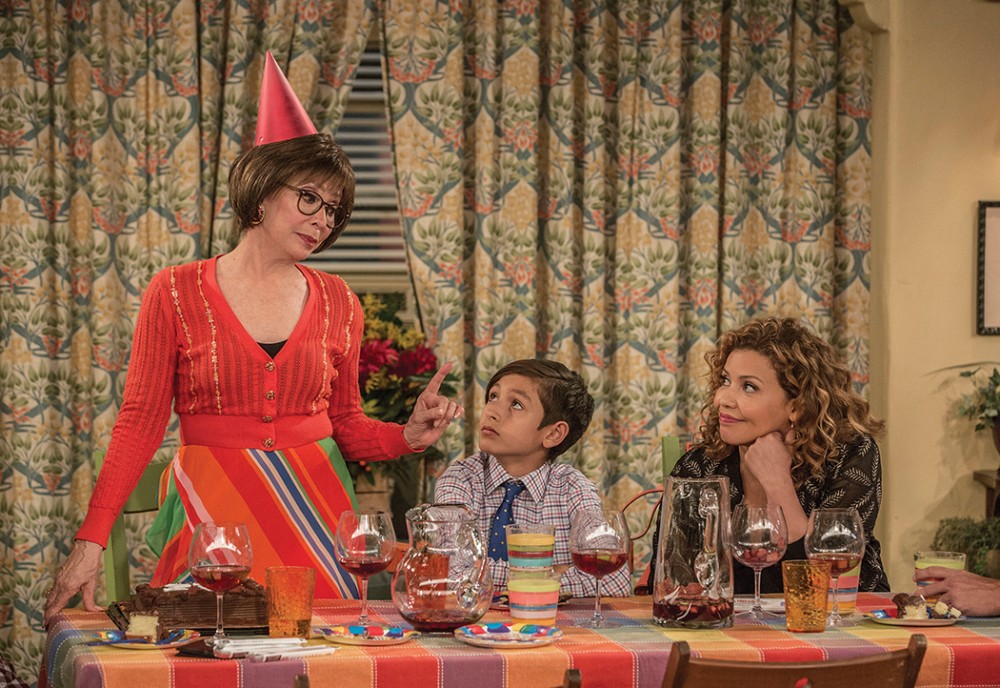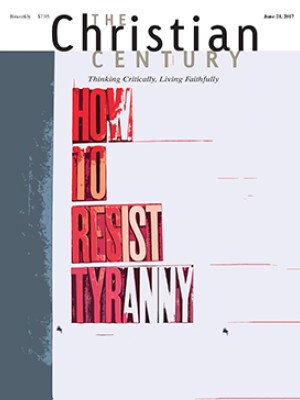One Day at a Time and the many ways to be Latina
The sitcom offers a complex and funny look at ethnicity, gender, and faith.

A few minutes into the third episode of Netflix’s serial comedy One Day at a Time, a heated family discussion takes place on the importance of religion for the three generations of the Alvarez family. The central character, Penelope Alvarez (Justina Machado), wants to go for a hike on Sunday and thinks it would be a good family bonding event. But that would mean skipping church. Her Cuban-born, fervently Catholic mother, Lydia (Rita Moreno), insists they go to church. She underscores the importance of church by telling a story about her Great Uncle Recito, who once skipped church and on the same day was crushed by a runaway tractor.
Meanwhile, 12-year-old Alex (Marcel Ruiz), the darling of his grandmother’s affections, likes church because there “I see my friends. I eat some donuts.” Fourteen-year-old Elena (Isabella Gomez) intellectually pokes at her grandmother’s faith, asking if she really believes she’s eating the flesh and blood of Jesus during communion. Lydia responds, “Ay! No, it’s a symbol. Don’t be gross!” When Penelope claims that that makes her a Protestant, Lydia retorts, “There is no need for name calling!”
Read our latest issue or browse back issues.
It is rare enough that a television show offers us a complex and funny take on church and theology. The writers of One Day at a Time give us an unexpected romp into the dynamics of family and faith, often packed into hilarious three-minute scenes. An added benefit is that the voices in the show are those of Latinas, whose life experiences are rarely approached with any complexity in popular culture representations.
Throughout the first season of One Day (recently renewed for a second season), religious tensions arise across the three generations. At issue is adherence to devotion and tradition, but also to familial authority. To the credit of the writers (and especially creator Gloria Calderón Kellett), devotion and authority aren’t easily distinguishable, just as they aren’t in real life. Ultimately, One Day indicates how tradition is not easily discarded, even as it must be transformed.
One Day at a Time is a remake of a popular sitcom that ran from 1975 to 1984. The older One Day at a Time was remarkable in its moment because it was woman-centered, focusing on the experiences of a divorced woman trying to raise her children by herself. Men circled like satellites, only occasionally exerting any gravitational pull.
The new One Day at a Time has the same setup, and like its predecessor it tackles current hot issues. These have, of course, shifted over the decades. The new show includes a number of issues vital to Latino life today, including immigration, acculturation, sexuality, race, ethnicity, language, and religion. All this is overlaid with familial foibles to which many viewers, Latina or not, can relate.
The show reveals not only the evolution of American culture but an evolution in the representation of Latina identity, especially through Moreno’s formidable presence. In 1961 when Moreno starred in West Side Story, she and other Latino/a actors had to wear brown makeup so that they would appear as the darker-toned Sharks next to the supposedly Anglo Jets. Moreno has become one of her generation’s greatest actors, one of the very few artists to claim an EGOT—she’s won an Emmy, a Grammy, an Oscar, and a Tony—as well as a Presidential Medal of Honor. Now 85, she farcically exaggerates the Latina stereotype that she’s had to earnestly play in previous years: she’s a heavy-accented, salsa-dancing, dramatic-gesturing, lipstick-wearing Catholic.
Alone, this would be a cheap trick (witness Sofía Vergara’s character in Modern Family), but in One Day Lydia is contrasted with her daughter, Penelope, and granddaughter, Elena, who open up other ways of being Latina and other ways of being religious. The contrast allows us to see an expansion and a complexity in what it means to be Latina in today’s America.
The portrayal of Lydia’s faith in the show is straightforward: she believes in a (male) God that acts in history. As the third episode crescendos and the argument about church continues, she tells Penelope about how she prayed for her when she was fighting in Afghanistan and insists that it was God’s hand that kept her safe. With a lesser actor, the character could come off looking simplistic, and cynics could rest assured that she’s deluded. But when it’s Rita Moreno fervently making the theological claims, it’s hard not to be a believer. The genius of Moreno’s acting is that she can make a farfetched comment about causal relations between skipping church and being run over by a tractor be funny and powerful at the same time. When she switches into an earnest mode, her audience is still listening.
The three generations of Latinas, all living in the same apartment, are contrasted with the apartment building superintendent, Schneider, a Euro-American trust-fund hipster. Schneider lives alone yet constantly wriggles his way into the Alvarez family, showing up at dinner time and in the morning for a Cuban coffee. He participates in the conversations but misunderstands much. He’s the medium for Anglo-Americans watching the show who don’t understand the traditions and nuances of the Latina family.
When Schneider enters the argument about church, he queries why they can’t just go to church and then go for a hike afterward. Penelope explains that because they’re Latinos church takes all day: after mass you have to say hello to everyone and by the time you’re done saying hello, it’s five o’clock. (Lydia says no, this is an exaggeration, it’s only four thirty.)
In another episode, the Alvarez family discusses sexism in the workplace, providing quick lessons on microaggressions and “mansplaining.” Penelope has been having a hard time with a jocular, sexist coworker whom her male boss has favored. Lydia says she doesn’t know what the term mansplaining means. Schneider quickly starts explaining it to her. The family stares at him until he stops and gets it: he’s doing the mansplaining. Schneider is charming because he’s just self-conscious enough to know when to stop. As the surrogate for white, male culture, he takes a backseat to the Latinas’ views, which is a struggle for him: being in front is his default place of privilege. The complexity of this encounter is treated with humor and a light touch. Schneider is welcomed into the family, even as he misunderstands it.
Elena has the primary task of confronting and remaking the tradition that she is being given by Lydia. The entire season weaves in and out of preparing for and finally celebrating Elena’s quinceañera. Protesting patriarchy, Elena is at first vehemently opposed to participating in this antiquated rite of passage from her Cuban heritage. Her acceptance is carefully threaded through a complex set of circumstances that are not about conceding to pressures of culture or family in order to make everyone happy. Instead, Elena begins to see the event as a way to show who she is and to display something about her mother, who is raising her without a father.
The final rite of passage ignores any ceremony in a church, and while Lydia has worked hard making a special, traditional dress for Elena—white, sparkly, fluffy—in the end she retailors it into a pantsuit that’s more Elena’s style.
When Elena steps out onto the dance floor in the season finale, at first alone and then embraced by the two older generations of Latina women, and eventually by a larger reconstituted family (including Schneider), the way is paved for a powerful transformation of ritual. Elena’s quinceañera is a “coming out” party, though in a delightfully subverted way. As the rite is remade, the community is re-formed and evolves into something new.
Particularly through the quinceañera, but also through ongoing conversations with her mother and grandmother, Elena reinvests the traditions and stereotypes with meaning, adapting them to new beliefs and practices, in new lands and languages. In the process, her mother and grandmother are also transformed, and so are the stereotypes of Latinas in the media. For anyone invested in the remaking of traditions, Elena is one to watch.
A version of this article appears in the June 21 print edition under the title “Latina faith and family.”





